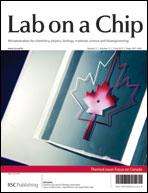Recent developments in microfluidics-based chemotaxis studies
Abstract
Microfluidic devices can better control cellular microenvironments compared to conventional cell migration assays. Over the past few years, microfluidics-based chemotaxis studies showed a rapid growth. New strategies were developed to explore cell migration in manipulated chemical gradients. In addition to expanding the use of microfluidic devices for a broader range of cell types, microfluidic devices were used to study cell migration and chemotaxis in complex environments. Furthermore, high-throughput microfluidic chemotaxis devices and integrated microfluidic chemotaxis systems were developed for medical and commercial applications. In this article, we review recent developments in microfluidics-based chemotaxis studies and discuss the new trends in this field observed over the past few years.

- This article is part of the themed collection: Focus on Canada

 Please wait while we load your content...
Please wait while we load your content...